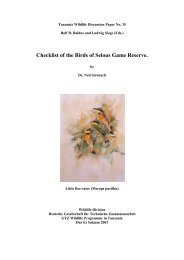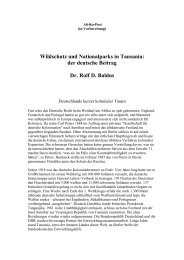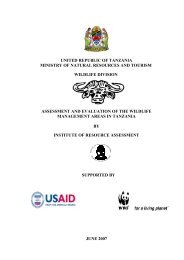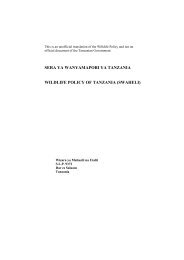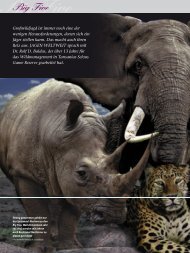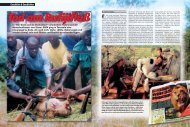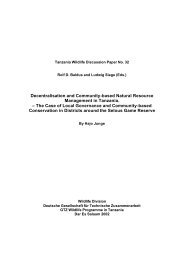African Indaba Articles - wildlife-baldus.com
African Indaba Articles - wildlife-baldus.com
African Indaba Articles - wildlife-baldus.com
You also want an ePaper? Increase the reach of your titles
YUMPU automatically turns print PDFs into web optimized ePapers that Google loves.
make a distinction between “<strong>wildlife</strong> management for conservation” and “<strong>wildlife</strong> manipulation for selectivebreeding of individual species”, since otherwise serious interpretation problems and misunderstandings mayevolve.The “South <strong>African</strong> Conservation Revolution”, as Peter Flack 31 termed it, saw private land under gameincrease by a <strong>com</strong>pound rate of 5.6% or 500,000ha pa over the last 10 years according to empirical studiesby Prof. T. Eloff of Potchefstroom University. Hunting was a main driver of this phenomenal development andhunters, game ranchers and game capturers were and are the heartbeat of what has not only brought somany species back from the brink of extinction but has created the biggest conservation success story on ourcontinent (Flack, 2002).Scientifically sound ecological principles must remain one of the underlying purposes of privateconservation and <strong>wildlife</strong> management. To deservedly use the proud phrase “The South <strong>African</strong>Conservation Revolution”, the stakeholders in the <strong>wildlife</strong> industry – in particular the landowners – mustensure that the conservation of biodiversity on their land is based on these principles. Economics andsustainable financial returns on investment are other factors to be considered. Last not least, a successful<strong>wildlife</strong> industry which aims at broad-based public support must take socio-political aspects into account.The future of the private conservation efforts as important contribution towards the National ConservationStrategy of South Africa will rest on the correct <strong>com</strong>bination of these three pillars of sustainability: Ecology(measured in the conservation contribution, the diversity of indigenous species in healthy habitats, andimprovement of genetic diversity, etc); Economy (capability for yielding a return on investment andprofitability, conservation self-sufficiency, etc.), and Social Responsibility (public interest of conservation,identifying, addressing and solving the issues of BEE and <strong>com</strong>munity participation, traditional indigenoushunting, etc.). Not one of these three pillars can be excluded. Therefore a “Triple Bottom Line” approachappears to be the only solution.The mentioned phenomenal success of private <strong>wildlife</strong> conservation and the breathtaking speed ofconversion of agricultural land (for crops and/or live stock) to game habitat also brought negative out<strong>com</strong>es.Some land owners ruthlessly aim at the <strong>com</strong>mercialization of the resource <strong>wildlife</strong> without consideringecological and social requirements. In many case an entire litany of pseudo conservation arguments areused to give the operation a conservation alibi. These operators often tout their particular managementphilosophy as good conservation practice and are often successful in marketing their properties asecotourism and/or hunting destinations to a gullible public (Graupner, 2004 32 ).Graupner disregards the difference between “<strong>wildlife</strong> management for conservation” and “<strong>wildlife</strong>manipulation for selective breeding of individual species“ and that good <strong>wildlife</strong> management practices onprivate land need the “Triple Bottom Line” approach.Those who continue to advocate the mass breeding of lion for shooting purposes, those who practice thereleasing of mature “trophy specimens” of any game species just prior to a “hunt” on any propertyirrespective of size and those who breed freak color variations, intentional hybrids and exotic game speciesfor shooting try to sell this as “good conservation”. They are not only wrong, but with their errors of judgmentand actions they seriously hurt the future of private <strong>wildlife</strong> conservation and “Incentive Driven Conservation”.Peter Flack wrote in 2002: “to mention but one truism, anyone killing an animal – whether it be a lion or alizard – in a tiny, enclosed encampment, whatever you may call him, cannot by definition be a hunter. Hemay be a killer, a shooter or a pervert but he is not a hunter and what he is doing does not by any stretch ofthe imagination constitute hunting.”A sector within the game ranching industry insists that there is a major difference between practical<strong>wildlife</strong> management on private properties and that on protected areas owned by the State. These peoplerather want to be under the jurisdiction of the Department of Agriculture than the Department ofEnvironmental Affairs & Tourism. Sadly, they do miss the point entirely; their objectives are neitherecologically nor sociologically motivated – they only think exclusively in economic terms. Their rejection ofthe Triple Bottom Line principle reveals a distinct myopic problem.It is time that we make idiomatic distinctions to the various forms of the game ranching industry – just aswe distinguish between conservation hunting, game cropping and game culling. Game ranchers who strive31 “The Conservation Revolution in SA”, Peter Flack (2002), published in <strong>African</strong> <strong>Indaba</strong> Vol1/132 Some moral, ethical and management aspects of game breeding and hunting (Erich D. Graupner, 2004) on www.sagro.co.za21



